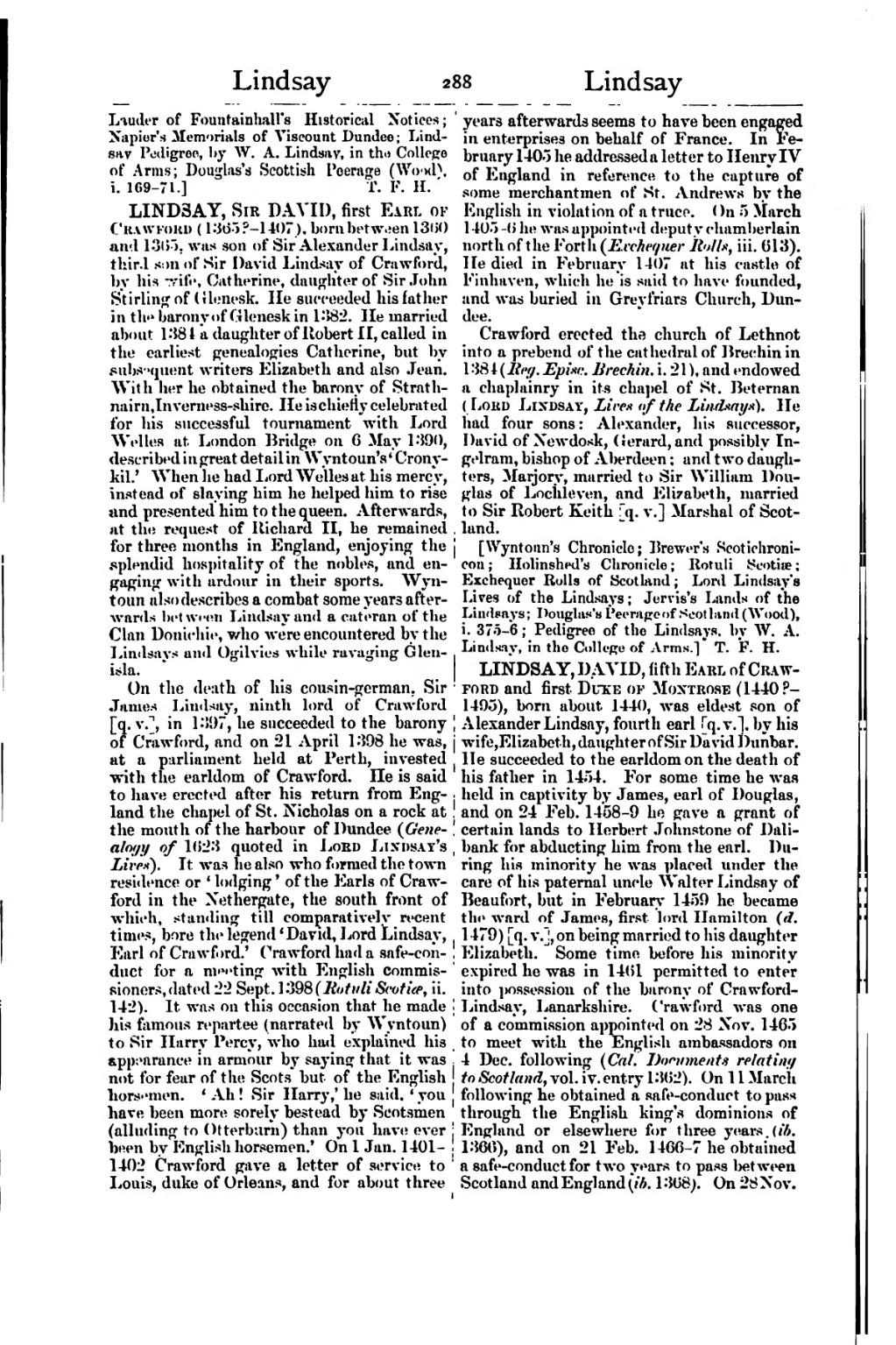LINDSAY, Sir DAVID, first Earl of Crawford (1365?–1407), born between 1360 and 1365, was son of Sir Alexander Lindsay, third son of Sir David Lindsay of Crawford, by his wife, Catherine, daughter of Sir John Stirling of Glenesk. He succeeded his father in the barony of Glenesk in 1382. He married about 1384 a daughter of Robert II, called in the earliest genealogies Catherine, but by subsequent writers Elizabeth and also Jean. With her he obtained the barony of Strathnairn, Inverness-shire. He is chiefly celebrated for his successful tournament with Lord Welles at London Bridge on 6 May 1390, described in great detail in Wyntoun's ‘Cronykil.’ When he had Lord Welles at his mercy, instead of slaying him he helped him to rise and presented him to the queen. Afterwards, at the request of Richard II, he remained for three months in England, enjoying the splendid hospitality of the nobles, and engaging with ardour in their sports. Wyntoun also describes a combat some years afterwards between Lindsay and a cateran of the Clan Donichie, who were encountered by the Lindsays and Ogilvies while ravaging Glenisla.
On the death of his cousin-german, Sir James Lindsay, ninth lord of Crawford [q. v.], in 1397, he succeeded to the barony of Crawford, and on 21 April 1398 he was, at a parliament held at Perth, invested with the earldom of Crawford. He is said to have erected after his return from England the chapel of St. Nicholas on a rock at the mouth of the harbour of Dundee (Genealogy of 1623 quoted in Lord Lindsay's Lives). It was he also who formed the town residence or ‘lodging’ of the Earls of Crawford in the Nethergate, the south front of which, standing till comparatively recent times, bore the legend ‘David, Lord Lindsay, Earl of Crawford.’ Crawford had a safe-conduct for a meeting with English commissioners, dated 22 Sept. 1398 (Rotuli Scotiæ, ii. 142). It was on this occasion that he made his famous repartee (narrated by Wyntoun) to Sir Harry Percy, who had explained his appearance in armour by saying that it was not for fear of the Scots but of the English horsemen. ‘Ah! Sir Harry,’ he said, ‘you have been more sorely bestead by Scotsmen (alluding to Otterburn) than you have ever been by English horsemen.’ On 1 Jan. 1401–1402 Crawford gave a letter of service to Louis, duke of Orleans, and for about three years afterwards seems to have been engaged in enterprises on behalf of France. In February 1405 he addressed a letter to Henry IV of England in reference to the capture of some merchantmen of St. Andrews by the English in violation of a truce. On 5 March 1405–6 he was appointed deputy chamberlain north of the Forth (Exchequer Rolls, iii. 613). He died in February 1407 at his castle of Finhaven, which he is said to have founded, and was buried in Greyfriars Church, Dundee.
Crawford erected the church of Lethnot into a prebend of the cathedral of Brechin in 1384 (Reg. Episc. Brechin. i. 21), and endowed a chaplainry in its chapel of St. Beternan (Lord Lindsay, Lives of the Lindsays). He had four sons: Alexander, his successor, David of Newdosk, Gerard, and possibly Ingelram, bishop of Aberdeen; and two daughters, Marjory, married to Sir William Douglas of Lochleven, and Elizabeth, married to Sir Robert Keith [q. v.] Marshal of Scotland.
[Wyntoun's Chronicle; Brewer's Scotichronicon; Holinshed's Chronicle; Rotuli Scotiæ; Exchequer Rolls of Scotland; Lord Lindsay's Lives of the Lindsays; Jervis's Lands of the Lindsays; Douglas's Peerage of Scotland (Wood), i. 375–6; Pedigree of the Lindsays, by W. A. Lindsay, in the College of Arms.]
LINDSAY, DAVID, fifth Earl of Crawford and first Duke of Crawford (1440?–1495), born about 1440, was eldest son of Alexander Lindsay, fourth earl [q. v.], by his wife, Elizabeth, daughter of Sir David Dunbar. He succeeded to the earldom on the death of his father in 1454. For some time he was held in captivity by James, earl of Douglas, and on 24 Feb. 1458–9 he gave a grant of certain lands to Herbert Johnstone of Dalibank for abducting him from the earl. During his minority he was placed under the care of his paternal uncle Walter Lindsay of Beaufort, but in February 1459 he became the ward of James, first lord Hamilton (d. 1479) [q. v.], on being married to his daughter Elizabeth. Some time before his minority expired he was in 1461 permitted to enter into possession of the barony of Crawford-Lindsay, Lanarkshire. Crawford was one of a commission appointed on 28 Nov. 1465 to meet with the English ambassadors on 4 Dec. following (Cal. Documents relating to Scotland, vol. iv. entry 1362). On 11 March following he obtained a safe-conduct to pass through the English king's dominions of England or elsewhere for three years (ib. 1366), and on 21 Feb. 1466–7 he obtained a safe-conduct for two years to pass between Scotland and England (ib. 1368). On 28 Nov.
